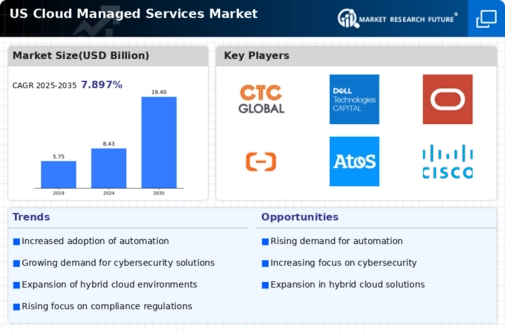Shift Towards Cost Efficiency
Cost efficiency remains a pivotal driver in the cloud managed-services market. Organizations are increasingly motivated to reduce operational costs while maintaining high service quality. By leveraging cloud solutions, businesses can minimize expenses related to hardware, maintenance, and staffing. Reports suggest that companies can save up to 30% on IT costs by migrating to cloud-based services. This financial incentive is particularly appealing in competitive markets, where every dollar counts. As a result, the cloud managed-services market is likely to see a growing number of enterprises transitioning to cloud solutions, driven by the need for sustainable cost management.
Growing Demand for Scalability
The cloud managed-services market experiences a notable surge in demand for scalability solutions. Organizations increasingly seek to expand their IT capabilities without incurring substantial capital expenditures. This trend is particularly pronounced among small to medium-sized enterprises (SMEs) that require flexible resources to accommodate fluctuating workloads. According to recent data, the market for cloud services in the US is projected to reach approximately $500 billion by 2025, indicating a robust growth trajectory. As businesses recognize the advantages of on-demand resources, the cloud managed-services market is likely to witness a significant uptick in service adoption, enabling organizations to scale operations efficiently and effectively.
Rising Importance of Data Analytics
Data analytics is emerging as a crucial driver in the cloud managed-services market. Organizations are increasingly recognizing the value of data-driven decision-making, prompting a shift towards cloud solutions that offer advanced analytics capabilities. The ability to process and analyze large datasets in real-time is becoming essential for maintaining a competitive edge. As a result, the cloud managed-services market is likely to see a rise in demand for services that integrate data analytics tools, enabling businesses to derive actionable insights from their data. This trend may also foster innovation in service offerings, as providers seek to enhance their analytics capabilities.
Enhanced Focus on Compliance and Governance
Compliance and governance issues are becoming increasingly critical in the cloud managed-services market. Organizations are under pressure to adhere to various regulatory frameworks, such as GDPR and HIPAA, which necessitate robust data management practices. The cloud managed-services market is responding to this demand by offering solutions that ensure compliance while maintaining operational efficiency. As businesses navigate complex regulatory landscapes, the need for managed services that provide compliance support is likely to grow. This trend may lead to an increase in partnerships between cloud service providers and compliance experts, further solidifying the industry's role in facilitating regulatory adherence.
Increased Collaboration and Remote Work Solutions
The cloud managed-services market is witnessing a significant shift towards solutions that facilitate collaboration and remote work. As organizations adapt to evolving work environments, the demand for cloud-based collaboration tools is on the rise. This trend is particularly relevant in the context of the US workforce, where remote work has become more prevalent. The cloud managed-services market is likely to benefit from this shift, as businesses seek to implement solutions that enhance communication and productivity among distributed teams. The integration of collaboration tools into managed services may also lead to the development of more comprehensive service packages, catering to the needs of modern workplaces.
























Leave a Comment